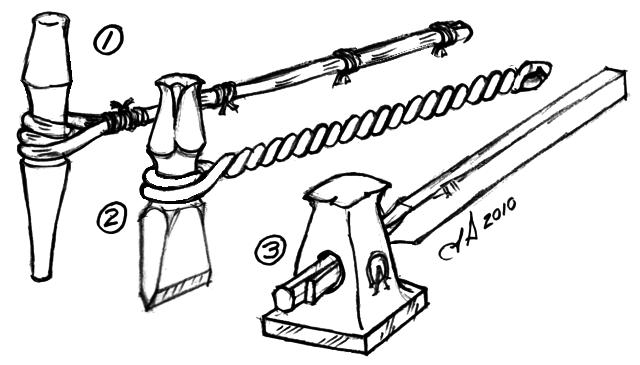Milton asks:
I am a new hobby blacksmith.
Yesterday I found a package deal from an antique dealer who is wanting to go out of business.
I bought hammers, flatters, punches, hot and cold cutters, top swages, and a few other things.
On the cutters, flatters, and some of the top swages I noticed the handles were very crude.
They were much looser then you would need for hammers.
They were wedged in, but no attempt to be even be close to the shape for a tight fit.
No wedges in the handles, either.
Was this customary for non hammer tools?
Thank you for your help.
Sunday, 02/21/10 11:34:16 EST
Answer:
Milton, Yes it is.
These tools are struck, usually by a striker but sometimes the smith.
Besides being cheap, quick and dirty handles, many suggest that being loose that they will not transfer vibration to the hands holding the tool.
Since these tools are often struck with sledges it is impossible to aim the tool with the handle any differently than the direction struck.
Therefore a tight handle has little purpose.
These handles also get accidentally struck and broken quite often, so putting a lot of time and expense into them is wasted.
I've seen handles in these tools made from soft pine furing strips, old broken hammer handles with the ends reshaped with an axe, broom handles and handles made of scrap flooring.
Prior to tools of this type having eyes for handles they had a fullered groove for a green sapling or wetted hazel rod "withe" handle
*.
Later these were replaced with a "wire" or rodded handle made from about 1/4" to 3/8" round bar wrapped around the tool then twisted together to form a long flexible handle.
Both of these are flexible and shock reducing.
The rodded type are still occasionally seen and are more popular in Europe than in North America.

1) Withe handle, wrapped and tied with cordage, sinue or rawhide. Used for 1,000 years or more
2) Rodded handle, 1/4 to 3/8" (7mm to 10mm) round bar wrapped around handle. Common until 1900's and still popular in Europe.
3) Tool with eye and typical rough wedged wood handle.
The withe handle was popular for a very long time due to the simplicity of the tool (no punching required),
the flexibility of the handle and ease of replacement.
The more permenant rodded handle replaced the withe when iron became cheap.
The tools are still simple to make and the twisted handle quite flexible.
Commercial tools with eyes became popular with drop forging due to the ease of manufacture and the "modern" design.
However, handles if tight and double wedged are stiffer than necessary.
Today, makers of short power and tredle hammer tools make them with a short double shouldered shank that can be gripped by a fitted pair of tongs.
This is similar to the old withe or rodded handle tools. Good ideas resurface over and over.
*
A Museum of Early American Tools, p.91, Eric Sloane, 1964, Funk & Wagnalls, New York.
Also The Art of Blacksmithing, p.87, Alex Bealer, 1969
Milton asks:
I am a new hobby blacksmith. Yesterday I found a package deal from an antique dealer who is wanting to go out of business. I bought hammers, flatters, punches, hot and cold cutters, top swages, and a few other things. On the cutters, flatters, and some of the top swages I noticed the handles were very crude. They were much looser then you would need for hammers. They were wedged in, but no attempt to be even be close to the shape for a tight fit. No wedges in the handles, either. Was this customary for non hammer tools? Thank you for your help.Sunday, 02/21/10 11:34:16 EST
Answer:
Milton, Yes it is. These tools are struck, usually by a striker but sometimes the smith. Besides being cheap, quick and dirty handles, many suggest that being loose that they will not transfer vibration to the hands holding the tool.Since these tools are often struck with sledges it is impossible to aim the tool with the handle any differently than the direction struck. Therefore a tight handle has little purpose. These handles also get accidentally struck and broken quite often, so putting a lot of time and expense into them is wasted.
I've seen handles in these tools made from soft pine furing strips, old broken hammer handles with the ends reshaped with an axe, broom handles and handles made of scrap flooring.
Prior to tools of this type having eyes for handles they had a fullered groove for a green sapling or wetted hazel rod "withe" handle*. Later these were replaced with a "wire" or rodded handle made from about 1/4" to 3/8" round bar wrapped around the tool then twisted together to form a long flexible handle. Both of these are flexible and shock reducing. The rodded type are still occasionally seen and are more popular in Europe than in North America.
Commercial tools with eyes became popular with drop forging due to the ease of manufacture and the "modern" design. However, handles if tight and double wedged are stiffer than necessary.
Today, makers of short power and tredle hammer tools make them with a short double shouldered shank that can be gripped by a fitted pair of tongs. This is similar to the old withe or rodded handle tools. Good ideas resurface over and over.
* A Museum of Early American Tools, p.91, Eric Sloane, 1964, Funk & Wagnalls, New York.
Also The Art of Blacksmithing, p.87, Alex Bealer, 1969